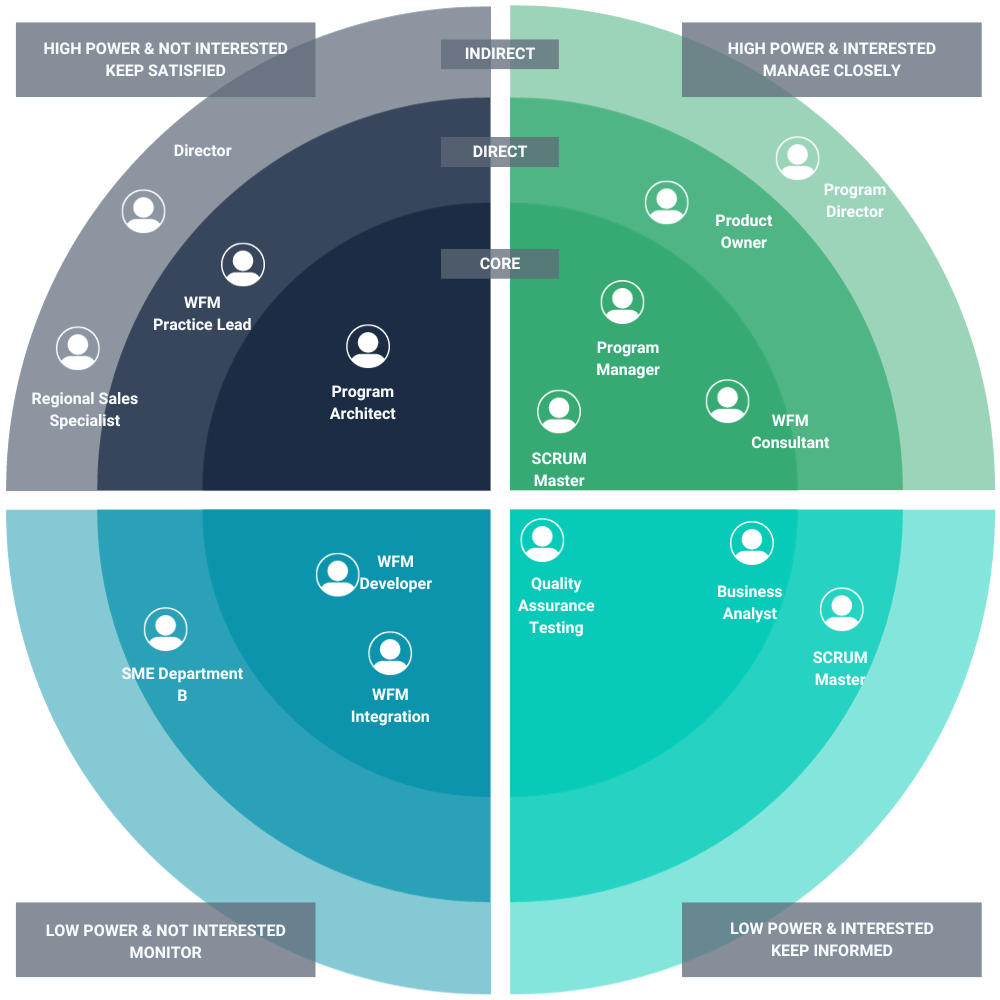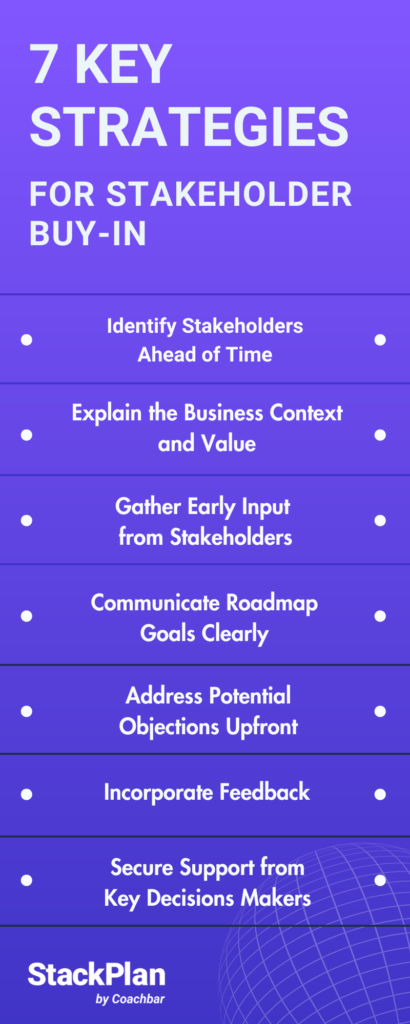The success or failure of any business project depends on many factors. But one of the most underestimated factors is the perception and support of the project across your organization.
If any key stakeholders don’t buy-in to the new project, they can easily derail progress and render any new implementation ineffective. Even worse, if they have objectives contrary to the project’s objectives, they will judge the project a failure even if the project delivers everything on time and on budget.
This is why securing stakeholder buy-in is crucial when developing a new technology roadmap. From team leaders and project managers to key decision-makers and specialist staff members, you need as much support, understanding and approval as possible to make your roadmap implementation a success.
But how do you secure stakeholder buy-in? And how do you convey the benefits and potential ROI of a new roadmap in a way that gets your team and people who will judge the project excited about the prospect?
Here’s a quick guide for getting stakeholders on board with your new technology project and some tips on how to overcome objections you might get along the way.
Identify Stakeholders Ahead of Time
Start by figuring out the stakeholders you’ll need to get on board so you can start planning your path for approvals.
It’s not just executives you need to think about – any team member involved in the implementation process needs to be on board and excited about the project.
You should end up with a visual that looks like an onion, with the most essential stakeholders in the middle, followed by layers of different roles and departments.
This is a great time also to identify any teams with unique needs so they can point out any constraints in the new solution early in the process. IT department input, specifically, will be a crucial piece of the puzzle when pitching new IT projects to upper management.
According to one study, around 75% of IT team members believe that projects are doomed from the start, so getting key team members on board is a must.

Explain the Business Context and Value
When you’re developing and refining your roadmap, always focus on the value it will bring with references to key ROI metrics. Your reviews should be relevant to each stakeholder, and you want to clearly show how the roadmap will benefit them so they understand it’s a priority.
Begin by explaining the challenge the business is facing and how this relates to strategic goals. Keep concepts high-level and relevant to the specific stakeholder here.
Research shows that 44% of business projects fail due to a lack of alignment between business goals and project objectives, so this is something that needs to be bridged early on.
Visuals are a great tool to help link the roadmap goals to organizational objectives and to show the real-world impacts on productivity, efficiency, and growth.
Time is limited, especially with executives, so a visual roadmap can help illustrate concepts quicker and help each person join the dots.

Gather Early Input from Stakeholders
To help build a compelling case for why you should prioritize an technology roadmap, gather and present early input from the teams closest to the project. This “insider” input will help you to articulate the key objectives and success metrics of your roadmap and give a more persuasive argument to management and high-level executives. Insiders can also help you gain perspective by sharing the success and failures of prior projects and prepare you for the objections and curmudgeons that exist in almost every organization.
Conduct interviews and surveys to understand the needs of stakeholders and team members in general. This will show you which projects should be a priority on your technology roadmap and encourage early acceptance from everyone involved.
Once you have all the data, you can draft a compelling roadmap draft that has detailed insights and success metrics built in.
Communicate Roadmap Goals Clearly
To get a positive response, you need to communicate in a way that stakeholders understand – and that’s talking about outcomes and performance improvements. Don’t just focus on how a technology roadmap will benefit the company; be specific about how it will help each stakeholder and their team.
Around 70% of all business projects fail. But that number is immediately decreased by 20% when an effective management strategy is put in place. This is your chance to convey how you plan on making this project a success.
It’s also important to be as clear as possible when communicating the objectives of the new plan. Provide an executive summary for any non-technical leaders, and clearly define the project scope and key outcomes.
Wherever possible, include statistics and measurable outcomes, and include visuals like timelines and diagrams to keep each stakeholder interested and excited. Using a technology roadmap template and working with an advisor, like a business analyst, can ensure your roadmap is successful, engaging, innovative, and functional.
If you’re struggling to draft a clear, captivating roadmap that will get leaders on board, our business analysts can help. Here at Tech Roadmaps, we specialize in developing strategic roadmaps that stakeholders are excited to implement.
Address Potential Objections Upfront
No matter how well you present your new technology roadmap, you will inevitably get some resistance. Try to anticipate any concerns over costs or disruption and explain how these issues will be mitigated. Prepare for these objections by talking the issues through with an experienced analyst and your insiders and sponsors.
Make it clear that a technology roadmap is a flexible plan that can adapt to changing needs. Show stakeholders where you plan on building in reviews to check on progress and how you plan on making changes if targets aren’t met.
Your technology roadmap may include more than one project or priority. By documenting your priorities and their impact on the business, you can reassure your stakeholders that all functional areas are being taken into consideration.
Team leaders may have suggestions to overcome some of their own objections, so this is a great time for collaboration.
Incorporate feedback
If you do get any insights or feedback from leaders, you need to be prepared with a process for implementing those suggestions. This will garner confidence in future projects and strengthen your relationship with team leaders and management.
Remember: this is your company’s roadmap not your roadmap. You will have less stress and anxiety and a lot more fun when you recognize the roadmap feedback is to help improve the business outcomes, not critique your work.
You’ll also need to identify team members who need to be informed of stakeholder feedback. Will you need to get additional approval? How will you decide what feedback to take on board and what is best set aside? Have you spoken to representatives of each of the system’s user types?
Having a process of incorporating and handling feedback will not only boost stakeholder buy-in for your roadmap but also give you the best chance of creating a successful, supported plan.
Secure Support from Key Decision Makers
Once you’ve gathered information and support from stakeholders and team members throughout the company, it’s time to meet with top leaders to gain sign-off. Be sure to discuss your concerns with top leaders as they can help you better describe project risks (e.g., insufficient time or budget) and create risk mitigation strategies (e.g., prioritizing project scope or adjusting the budget).
If you are choosing to hide issues to avoid tough stakeholder conversations, you could be setting yourself up potential complications down the line. Take the time to address those challenges with your stakeholders before everyone is caught off-guard.
Rally advocates of your plan to spread awareness, start a buzz about your new plans, and gain public endorsement from sponsors.
The more positive feedback and support you can get for your project, the easier it will be to get that final sign-off from top leaders in the company.
Final Thoughts
The only way any workplace project can be successful is with support from team members, stakeholders, and key decision-makers, as well as customers or vendors. Securing stakeholder buy-in for a technology roadmap ensures every department is working toward the same shared goals.
Make sure your stakeholders clearly understand what your roadmap aims to achieve, the key success metrics, and how their teams will benefit to gain their buy-in. But you don’t have to handle this part on your own. Our team of skilled business analysts here at Tech Roadmaps can help you develop your technology roadmap and simplify stakeholder communication.
Need Help Evaluating
your Current Inventory Systems?
Visit our directory of software consultants in the StackPlan Consultant Directory. Vetted consultants are ready to support your business needs.








